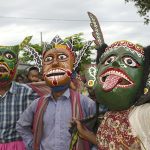The wooden mask of Kushmandi is hand-carved from a single piece of wood by skilled artisans. The mask is typically painted in bright colors with intricate designs and patterns. The masks are generally large and cover the face of the wearer completely. They are often decorated with feathers, shells, and other embellishments to add to their aesthetic appeal.
The history of the wooden mask of Kushmandi can be traced back to the indigenous tribes of the region however there is no manuscript of documentation of the origin of this art form. The masks were initially used as a part of traditional rituals and ceremonies. These rituals were aimed at invoking the blessings of the gods and warding off evil spirits. Over time, the use of the masks became more widespread, and they were adopted by various communities and social groups in the region.
Kushmandi masks are usually made of ‘Gamhar’ wood which is light. Mahogany and Mango wood is also used. The wood is made crack resistant by seasoning it which involves soaking and drying for multiple cycles. Chemical treatment is done to make it termite and bug resistant. After that the artisan carves out the design on the wood block. Finally the mask is painted with colors to make them vibrant and lively.
During the annual Bisarjan Mela, a festival that is celebrated in the town of Kushmandi. During this festival, the local people wear the masks and participate in colorful processions through the streets. The festival is a celebration of the triumph of good over evil and is celebrated with local food, music, and dancing.
Apart from its cultural and religious significance, the wooden mask of Kushmandi has also gained recognition as a unique art form. The intricate designs and skilled craftsmanship have earned the masks a reputation as valuable pieces of folk art. The masks are often collected by art enthusiasts and collectors from around the world.
In recent years, the popularity of the wooden mask of Kushmandi has grown significantly, and efforts have been made to promote and preserve this unique cultural heritage. The local government and cultural organizations have taken steps to support the artisans who create these masks and to promote the use of the masks in various cultural events and festivals.





